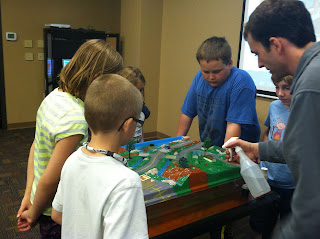Good morning Mrs. Clarey!!!
Thursday, May 23, 2013
Monday, May 20, 2013
Owl Pellets!
Check out what we are doing today!!! This is easily one of the favorites for the year, and my favorite part of the project is when the "Ewwwwws" turn into "Cool!"
What are owl pellets? Basically, after an owl swallows its prey (whole), its stomach digests all the parts of the animal that it can. What's left is bones and fur. The owl then regurgitates (or, in kid terms, pukes up) this "pellet." For those of you getting queasy right now, they are sanitized before they are sent to us!!! :)
Our process:
- make observations about size, shape, texture, and color
- break it in two
- partners begin working together to separate bones from fur
- categorize bones into the different areas of the skeleton & determine if the animal is a rodent, shrew, mole, or bird
- glue bones onto a copy of a skeleton to reconstruct their animal's body
We should be able to wrap up the project today, so look for some part of a skeleton to come home!
Friday, May 17, 2013
Public Works
Here are a few snapshots of our trip to Public Works on Wednesday. The students had the opportunity to learn about fire hydrants, water towers, & the city water system. If we remembered correctly, there are 1,376 fire hydrants in West Fargo. We also learned that last spring on one of the first hot days the city residents used 4 million gallons of water, which means we used approximately 3 water towers' worth. That's a lot of water!!!!! Thanks to Conner's dad and Max's dad, especially, who work at the facility and invited us out!!!
Tuesday, May 7, 2013
Buffalo River Field Trip
Wow! What a day! The students had a FABULOUS time, and we received several compliments from our guide (Tony) about our great behavior and language/vocabulary. Woot woot!!! Thank you, as well, to Joyal and Maureen for accompanying us on such short notice!!!
Our day in pictures:
Credit: Maureen via Instagram
Bus ride out...we weren't excited!
Opening discussion with Tony and Paula --- we discussed the 5 features of HABITAT.
This is Paula, and our list on the board behind!
^
One of our first group discussions as we checked out the prairie and began our adventure.
v
We noticed a gopher, which we learned is called "spermophilous tridecilineatus" (or something close to that). That is latin for thirteen-striped seed eater. Our morphographic spelling skills came in handy as we figured out that sperm=seed, philous=eater, tri=3, deci=10 (combine the numbers for 13), and lineatus=lined.
^
Seated between two deep ruts in the ground where the bison used to travel down to the river. They resemble ditches more than ruts due to the size and weight of the buffalo. We also learned how wolves would follow a herd of buffalo and wait for one to be injured, often times by walking down the steep ditches to rivers, and then wait until it was too stiff or weak to defend itself before attacking.
v
Along the trail we found a GIGANTIC ant mound that they had built using the prairie grasses. Tony estimated that there were billions of ants in the colony.
This igneous rock was moved down from the Hudson Bay area in Canada by glaciers many, many years ago. There is one spot on the rock that has been rubbed smooth over time by the hundreds of bison that used it as a scratching post. The area around the rock was also trampled into a depression, which would become a big mud pit during rainstorm (which we learned is called a wallow). Tony had us make careful observations of this rock and asked everyone to choose an adjective to describe it. Our choices ranged from rough, to green, to red, to mossy, to smooth, to jagged...
And of course we got to touch it!
The next picture shows the location of a lengthy analysis of an area with fur and various kinds of scat (poo). We decided that a wolf likely caught a rabbit (based on fur color and proximity to the wooded area), was scared away, and then a bird came to clean up the rest. The students were able to identify that the wolf was the predator, the rabbit was the prey, and the bird was the scavenger. They then discussed what all those animals eat, and determined carnivores, herbivores, and omnivores.
The Buffalo River
The "ball" on the top of this goldenrod stem forms around the egg of a fly (I can't remember if it's a certain kind of fly), the egg hatches into larvae and grows inside the bulb, and then a bird came and ate it through the hole in the side.
One big mushroom!
A woodpecker went to town on this tree!
Subscribe to:
Comments (Atom)









































































